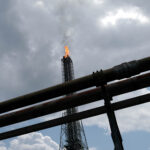Energy News Beat
LONDON – Energy giants offered a rare glimpse into their liquefied natural gas (LNG) trading strategies in recent days, with Shell’s and TotalEnergies’ bets on rising Asian demand paying off while BP’s bet on a European deficit turned sour.
Source: Reuters
The contrasting outcomes highlight the risky nature of trading divisions, at times notching up spectacular profits as traders quickly exploit price swings and supply and demand disruptions around the world to make money, but at other times losses have been just as spectacular.
Companies rarely reveal details on their trading activities beyond general commentary on their performance, but executives this week shed some light on their performance in the third quarter.
ShellSHEL.L and TotalEnergiesTTEF.PA successfully bet on rising Asian demand for LNG ahead of winter, resulting in strong earnings from trading. BP’sBP.L focus on Atlantic basin markets, where demand was muted due to full inventories, led to a sharp drop in trading profits.
BP’s third quarter profits of $3.3 billion missed analysts’ forecasts by around 20%, partly accounted for by poor LNG trading results.
“Gas trading was exceptional in the first quarter, exceptional in the second quarter and had a weak quarter in the third quarter. That’s just from a lack of structure inside the markets,” BP interim CEO Murray Auchincloss told Reuters.
“Trading organizations make money on volatility. And there was just no volatility,” Auchincloss said.
The lack of volatility stemmed from high inventory levels in the U.S. and European markets as European buyers stocked up to avoid a repeat of record gas prices last winter after Russia cut off major gas supplies into Europe.
Oswald Clint, analyst at Bernstein, said that “BP is more active in LNG trading in the U.S and Europe.”
On the other hand, “Shell and TotalEnergies are more exposed to the LNG arbitrage (differences in prices) between the East and West and this was open in the third quarter,” he added.
“Asian buyers are back in the LNG business,” TotalEnergies CEO Patrick Pouyanne told analysts last week. “Today, most of the cargoes are going to Asia because the spot market is in favor of Asia.”
A Shell spokesperson said the strong earnings from LNG trading benefited from “arbitrage opportunities due to seasonal weather effects” including heatwaves in Europe and Asia, as well as uncertainty over LNG production in Australia due to threatened industrial action.
The trading results helped Shell weather a drop in LNG production due to maintenance at several key plants, including its 3.6 mtpa Prelude floating LNG production facility off the coast of Australia.
Shell is the world’s top LNG trader, shipping around 66 million metric tons in 2022, 16.5% of the global LNG market of 400 million tons per year (mtpa).
TotalEnergies, the second largest, shipped 48 million tonnes last year. BP traded around 25 million tonnes last year, according to analysts and traders.
The post Energy giants’ LNG trading results reveal diverging regional bets appeared first on Energy News Beat.








